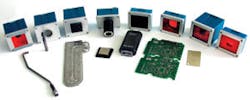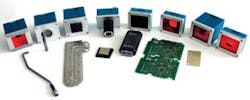Modular lighting speeds code inspection
By Andrew Wilson, Editor, [email protected]
Choosing the correct lighting is probably the most important factor when developing a machine-vision or image-processing system. By properly increasing the contrast of features to be measured, a sharper imager is captured by the imaging device and the host processor offloaded from functions such as background noise removal and contrast enhancement, in effect easing the task of pattern recognition.
“This,” says Harald Richter, managing director of Intelligente optische Sensoren und Systeme (IOSS; Radolfzell, Germany; www.ioss.de), “is especially true in direct marking applications, where 2-D Data Matrix codes are dot-peened, stamped, lasered, or printed on plastic, glass, metal, wood, or ceramic products.” Not only can the surfaces of these products be shiny, specular, or diffuse, many are contoured with Data Matrix code irregularly stamped upon them. “Such codes also vary in size from 0.3 × 0.3 mm to 25 × 25 mm, making proper illumination vital.
Today, many companies manufacture a number of different off-the-shelf lighting components that can be used with standard CCD or CMOS cameras to perform 2-D Data Matrix reading. These include Siemens Energy and Automation (Nashua, NH, USA; www.nerlite.com), Advanced Illumination (Rochester, VT, USA; www.advancedillumination.com), and Spectrum Illumination (Montague, MI, USA; www.spectrumillumination.com).
In choosing to develop a system using off-the-shelf cameras and lighting systems, however, system developers also need to consider the cost of incorporating Data Matrix code-reading software into their systems. In many cases, this can far outweigh the cost of purchasing an off-the-shelf Data Matrix code reader.
Fully aware of this, manufacturers such as Cognex (Natick, MA, USA; www.cognex.com) and Siemens Energy and Automation (Nashua, NH, USA; www.acuitycimatrix.com) have developed direct-part-mark readers with built-in lighting. In the design of its DataMan 7500 readers, for example, Cognex has incorporated a custom LED design that offers on-axis, off-axis, and dome illumination (see Vision Systems Design, February 2006, p. 43).
Rather than offer the developer a Data Matrix reader with fixed illumination, IOSS has taken a modular approach in the design of its DMR210 Data Matrix reader. “From the outset,” says Richter, “we realized that not every part could be read using a fixed-lighting approach. Rather, our system integrators demanded a more flexible approach so that different types of lighting could be easily incorporated with the reader.
IOSS developed a series of more than 14 LED-based illumination modules that can be used with the company’s DMR210 reader. These include a cloudy day illuminator, dome light, coaxial illuminator, direct LED illuminator, spot, and IR LED illuminator, each of which has been developed to meet the needs of a specific application (see figure on p. 26).
“For shiny, uneven cylindrical surfaces,” says Richter, it is important to provide the greatest degree of even light coverage to illuminate the part.” Such lighting is ideal for long cylindrical automotive parts that can be inspected at working distances of approximately 15 mm from the Data Matrix reader. Similarly, square LED illuminators incorporating Fresnel lenses are ideal for inspecting Data Matrix code on PCBs. “The code on PCBs can be placed up to 100 mm from the reader and need a strong LED spotlight within a relatively small 20 × 20-mm field of view to illuminate them,” says Richter.
To perform direct part marking, each IOSS illumination module can be attached to the DMR210 reader. Incorporating a 640 × 480 CCD sensor from Sony (Park Ridge, NJ, USA; www.sony.com) and an onboard 6700 series DSP from Texas Instruments (Dallas, TX, USA; www.ti.com) running Data Matrix code software, the unit is supplied with up to 32 Mbytes RAM and an Ethernet interface. For factory-automation applications, the unit’s digital I/O and RS-232 outputs can be used to directly drive a programmable logic controller.
“When designing the DMR210,” says Richter, “we also realized that many system integrators might need to add a variety of fixed-focal-length lenses to reach their goals.” Because of this, IOSS also offers a number of different lenses ranging from 10 to 75 mm that can be added using a C-mount adapter. “In this way,” says Richter, “both the illumination and lenses can be mixed and matched to meet a variety of applications.”

